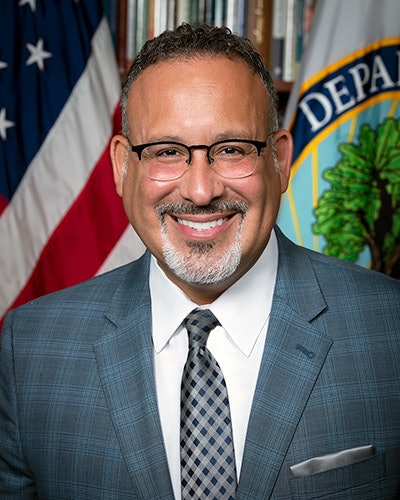The Departments of Education and Justice have published their guidance on the Supreme Court’s race-conscious admissions ruling, offering clarity to colleges and applicants about the post-affirmative action landscape.
Although the guidance, which takes the form of a Dear Colleague letter and a seven-page question and answer document, does not have the force of law, it still matters, according to Dr. Liliana Garces, the W.K. Kellogg Professor of Community College Leadership at the University of Texas at Austin.
“It’s an important resource for institutions to really understand what the decision did and did not do,” she said.
The guidance is particularly crucial in an environment in which unofficial sources have sought to provide interpretations of the ruling, said Dr. Dominique Baker, an associate professor of education policy at Southern Methodist University. In July, Students for Fair Admissions, the plaintiff in the Supreme Court cases, sent an email to 150 colleges and universities, claiming that schools could not receive data about applicants’ races or even have any “definition or guidance” about underrepresented groups.
 Dr. Miguel Cardona, U.S. Secretary of Education
Dr. Miguel Cardona, U.S. Secretary of Education
“Students should feel comfortable presenting their whole selves when applying for college,” the Dear Colleague letter said. According to the guidance, race and ethnicity can be considered, insofar as they relate to applicants’ lives.
“A university could consider an applicant’s explanation about what it means to him to be the first Black violinist in his city’s youth orchestra or an applicant’s account of overcoming prejudice when she transferred to a rural high school where she was the only student of South Asian descent,” the Q&A noted.
“An institution could likewise consider a guidance counselor or other recommender’s description of how an applicant conquered her feelings of isolation as a Latina student at an overwhelmingly white high school to join the debate team,” the Q&A continued. “Similarly, an institution could consider an applicant’s discussion of how learning to cook traditional Hmong dishes from her grandmother sparked her passion for food and nurtured her sense of self by connecting her to past generations of her family.”
The guidance reminded schools that the goal of a diverse campus is still legal and that they can use other factors to achieve it, including applicants’ socioeconomic status, data about their neighborhood or high school, and experiences of adversity, including racial discrimination. Colleges are also allowed to offer admission based on attendance at certain high schools, or to admit all the students who graduate at the top of their high school class. So-called “percent plans” may have helped schools in several states where race-conscious admissions had been banned maintain some of their diversity, although they have not been as effective as taking race directly into account. Institutions can also remove legacy preferences and other advantages that tend to benefit privileged students.
 Dr. Liliana Garces, the W.K. Kellogg Professor of Community College Leadership at the University of Texas at Austin
Dr. Liliana Garces, the W.K. Kellogg Professor of Community College Leadership at the University of Texas at Austin
Conversely, if a program doesn’t use race as a factor—i.e. it is open to all juniors at a particular high school school—the college can give those students a preference. Schools seeking to maintain diversity might take advantage of this by hosting these programs at high schools where minoritized students predominate.
The departments also emphasized that the Supreme Court’s decision only addressed admissions programs—not racially or ethnically-based scholarships and hiring. Others had taken a broader view: in the hours after the decision, Missouri attorney general Andrew Bailey issued an order that state schools had to drop minority scholarships, and the University of Missouri swiftly complied. They weren’t the only ones who thought that race-based financial aid was off the table. The president of the University of Kentucky told students that that was the school’s interpretation, and Western Illinois University revoked funds from students of color who had been promised them before reversing itself.
“This type of guidance provides additional evidence to say that [race-based scholarships and hiring] are perfectly fine and legal,” said Baker. “If someone’s going to say you can’t consider race for scholarships or hiring based on the Supreme Court’s decision, those people are making that up.”
The documents also noted that schools are free to take steps to ensure that students from underrepresented backgrounds are comfortable on campus and likely to stay. Universities can build a sense of belonging through diversity offices, cultural centers, and other resources, so long as the support services are available to all students, the guidance said. Clubs, activities, and affinity groups, as well as meetings and assemblies on race-related topics, are all allowed, provided that all students are welcome to participate.
“Given the attacks on DEI efforts, I think it’s important for us to hear,” said Garces. “It’s also addressing that this decision can be interpreted by a lot of students of color as a message that they don’t belong at selective institutions. It becomes really important for institutions to counter that message. This is guidance that helps bolster those efforts.”
The Biden administration has promised further steps in response to the Supreme Court ruling, including collecting and publishing more data about college admissions and enrollment and helping states to analyze available information to increase access to educational opportunity. The Department of Education will also deliver a report on strategies to increase diversity, including the use of measures of adversity. That report is due in September.
Jon Edelman can be reached at [email protected]


















